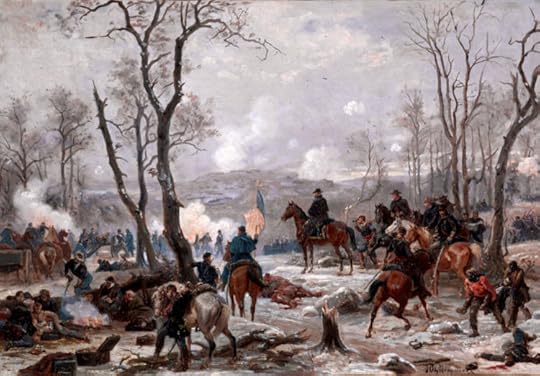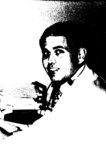Fort Donelson’s Walking Dead
 Grant at Fort Donelson by Paul D. Philippoteaux.
Grant at Fort Donelson by Paul D. Philippoteaux.In February of 1862 the Union army launched a major campaign against Forts Donelson and Henry. These twin Confederate bastions stood guard over the Tennessee and Cumberland Rivers along the border with Kentucky—still technically neutral–and which together formed a barrier keeping the Federal armies from invading the western Confederacy.
It so happens that, just as the twin rivers empty into the Ohio River, the two rivers come close to one another, forming a narrow region once called Land Between the Rivers—today Land Between the Lakes, thanks to the damns built by the TVA in the 20th century. Control of this strategic conjunction of land and river was vital to both sides in the struggle for dominion in the western theater of war.
It was here that in the winter of ‘62 that an amphibious force of Federals came to break the Confederate defenses, a move which would change the course of the war. Led by General Ulysses S. Grant and accompanied by a naval flotilla under Flag Officer Andrew Hull Foote, the Yankee flotilla of tortoise-like ironclads first bombarded Fort Henry on the Tennessee River, pounding it into submission with the big guns of the ironclads.
At this point General Grant, still technically a brigadier, was supposed to halt at Fort Henry, occupy it and await his superior, General Henry Halleck, to come up with reinforcements, at which point the Federal fleet would go back up to the Ohio and then descend down the Cumberland River to bombard Fort Donelson. General Halleck, nicknamed “Old Brains,” was a cautious general, more concerned with not losing than actually winning a battle.
However, in a bold move Grant landed his small force, then marched them overland and besieged Fort Donelson from the landward side, catching the Rebel garrison off guard. The Confederates, it turned out, had all their big guns pointing down-river, in the direction they thought the Yankee fleet would come.
February of 1862 was a bitter cold time. Soldiers on both sides suffered terribly from frostbite and exposure to the elements. Wounded, trapped in the no man’s land between the two armies, suffered as much from icy weather as from wounds received in battle and many Union soldiers, with survivable wounds, died a slow and agonizing death on the outer slopes before Fort Donelson. The Rebel troops, wearing lightweight uniforms, were ill-prepared for a winter campaign and were short of food to boot, so behind their steep parapets they too suffered from the winter weather.
After several Rebel attempts to break the siege, all of them bloody failures, Grant ultimately bluffed the incompetent Confederate commanders into surrendering. When the Confederate generals, political appointees, asked for terms, Grant replied that his terms were “Unconditional Surrender,” thereby assuring his fame and opening the way into the heartland of the Confederacy.
Once the twin forts fell and prisoners herded up to journey to the cold, cold north, the dead were quickly interred in the ground. But there are many who say that their shades linger still at Land Between the Lakes, and some dead still walk its trails, paths and by-ways. Visitors, guides and costumed re-enactors all have their own tales to tell regarding the restless dead of Fort Donelson and the lands that surround it.
After my first book, Strange Tales of the Dark and Bloody Ground, which chronicled several Civil War ghosts and haunts, and even more so after Ghosts and Haunts of the Civil War, I had occasion to talk with several re-enactors who have camped at Fort Donelson at various times, in earnest endeavors to try and re-create conditions as close to that of February, 1862, as they may. Re-enactors with whom I have spoken told me it is not uncommon for one or another of their ranks to have uncanny encounters at Fort Donelson.
One, a sutler, describes awakening in her tent in the dead of night to see all her wares violently rattling to and fro and her tent shaking down to the stakes. Yet there was no wind or storm or any such natural event that night that might explain it. Apparently there was something–something supernatural–that could. Nor was she the only camper to experience incidents they could not explain rationally.
In March of 2016, a family visited the Fort Donelson National Battlefield, following the signage that dots the fort and its environs. The Fort as it stands today is a large earthen redoubt, all the wooden shacks, tents and artillery long since gone. The whole is surrounded by a steep embankment, ending in a dry moat. It was here that many men in blue lost their lives, as well as some in gray who counterattacked the Yankee horde. As they wandered close to the ravine, on a whim they did a few recording sessions as one sometimes sees on TV; in this case they actually got a “no” in response to a question.
Later, as they were leaving this same part of the battlefield, they distinctly heard loud footsteps rustling the leaves in the ravine:
“we went down close to the area and saw absolutely nothing. We looked for wildlife, birds, squirrel. ANYTHING that could have been making the noise. Funny thing is we kept hearing it around us but nothing was there.”
They repeatedly heard the sound of feet walking or marching, yet no one and nothing was visible. In 2021, a small group of investigators from the Ghost Research Society also visited the fort; they too saw nothing but did record a number of clear voice responses to questions posed by the team.
Previous visitors to Fort Donelson and the surrounding battlefields claim that long dead soldiers still walk the lands of Fort Donelson, and report hearing gunshots, the sounds of marching neb, and cannon. On rare occasion people have reported hearing an eerie ghostly sound of the Rebel Yell echo across the ramparts of the fort.
Near to the fort, and also administered by the National Parks, is Surrender House. This is were the formal Confederate surrender was signed and where Grant first made his fame. At the time of the battle, it was known as the Dover Hotel, a small two-story establishment built in the 1850’s, it accommodated riverboat travelers before and after the Civil War. General Buckner and his staff used the hotel as their headquarters during the battle and also served as a Union hospital after the surrender. Only the first floor of the hotel is open to the public and has minimal signage to explain the building’s importance. Nevertheless, disembodied voices and ghostly apparitions sometimes startle visitors of the Surrender House, which tends to make the brief visit to the site even shorter than intended.
Not far below the fort and near to the National Cemetery, there used to be a well-appointed bed & breakfast: the Riverfront Plantation Inn. It was an antebellum home built in 1859, which in recent times was converted to a luxury Bed and Breakfast. Located on Crow Road, it was sometimes referred to ‘Crow Home’, and was a great place to stay in the area; sadly, it burnt down in 2008.
During the siege, the Riverfront Plantation Inn was used as a field hospital, and here many of the wounded and dying were brought for care. Not surprisingly, it also is said to boast some resident spooks, mostly those of injured soldiers, and possibly also the spectral remnants of doctors and nurses who worked feverishly with very little equipment to save lives. In its heyday as a B&B visitors would report hearing the soft sound of voices talking indistinctly in the home, and doors would often open and close all on their own.
One of the most bizarre phenomena reported in the area is that of a ghostly river. According to reports, there is a little traveled back road near the historic area in which you have to pass through a nonexistent river! You can see and hear it flowing right before your eyes, but if you walk into its waters, you will not get wet. Very strange, even by paranormal standards. There are also accounts of some sort of man-beast, part wolf, part human, roaming Land Between the Lakes, but that is best left to the field of Crypto-Zoology, than hauntings per se.
Another paranormal phenomenon reported in the area of Fort Donelson is the so-called “Phantom Trucker.” While this may sound like a modern haunting, the actual reports by witnesses don’t talk about seeing any cars or trucks, but of eerie lights following them, sometimes just one light, sometimes more. From the eyewitnesses, this sounds more like Ghost Lights, an unexplained phenomenon that can occur almost anywhere, but is often associated with battlefields and places where tragedy has occurred.
Another Civil War reenactor told me of performing picket duty at night while his unit was there one year recreating the battle and siege. Many re-enactors try to get into the spirit of the period, not just for visitors during the day, but at night as well, and an onlooker might easily mistake them for the real thing.
This re-enactor was on duty late at night when he saw a light coming up the hill in the distance. The dim glow grew larger and larger as it approached him and, at first, he could not make out what it was. Then it came close by and passed him; in the eerie glow he could see the torso and head of a man, seemingly an officer, wearing a broad-brimmed hat and smoking an old-fashioned stogie; it was the phantom cigar that illumined the figure.
It almost seemed as if the phantom officer were making the rounds, checking on the bivouac to see all the guards were on duty. But the cigar-smoking figure was no re-enactor; he had no lower body, just a materialized torso and be-hatted head. Was it the ghost of General Grant? Or was it the shade of some other tobacco-loving commander, North or South? Who knows?
What we do know that accounts of people having paranormal encounters in the region of Fort Donelson are too numerous to mention. If you have any first-hand experiences to add to the roll of those encounters, you are welcome to add your reminiscences to those of others. Until then, enjoy reading about them from the comfort of your warm, well light, home.
For more Civil War ghost stories see my Ghosts and Haunts of the Civil War; Rutledge Hill did the original edition which is still in print, although Barnes & Noble, Lone Pine and Sterling have come out with economy hardcovers in addition to the paperback. My first book, Strange Tales of the Dark and Bloody Ground, also chronicles the battlefield hauntings of Shiloh, Chickamauga and Franklin.



